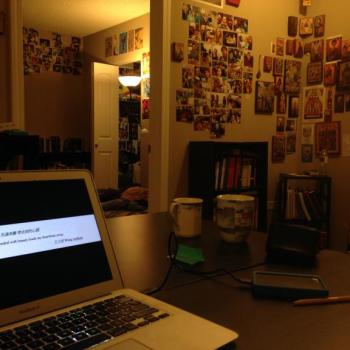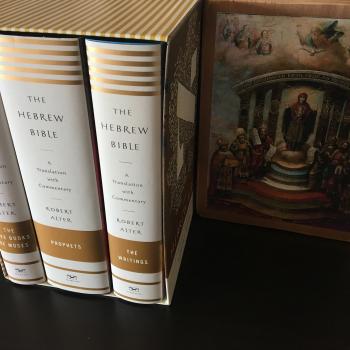![Disney Frozen Kellogg's Kid's Breakfast Cereal, 12/2014, pic by Mike Mozart of the TheToyChannel and JeepersMedia on YouTube #Frozen #DisneyFrozen - by Mike Mozart, 20 Dec 2014 (15881172670_730bc54f7e_o.jpg) (CC BY 2.0 [https://creativecommons.org/licenses/by/2.0/]), via Flickr](https://wp-media.patheos.com/blogs/sites/721/2014/05/15881172670_730bc54f7e_o-1024x625.jpg)
I found out recently that teaching on the Christian Right is a fairly gutsy thing to do at the University of Washington. It turns out that the Comparative Religion Unit was started because the ‘Christian Right’ (if you could call it that back then) sued the university in 1968. The case revolved around the English Department and its class, The Bible as Literature. In Calvary Bible Presbyterian Church v. Board of Regents of the University of Washington, 72 Wn.2d 912 (1968), a coalition of churches alleged that not teaching the Bible as ‘the Word of God’ meant that the university was favouring its own strand of (liberal) theology and was thus engaging in state-sponsored ‘religious instruction and indoctrination.’ The churches lost the case, the university started a Comparative Religion Unit, and the Jackson School housed it so that the study of comparative religion somehow became ‘international studies.’
I now work there.
I had a very vague sense of what that case was about when I started teaching the class, but in any case, the training that I already had in religion had developed in me the conviction to produce what Robert Orsi calls a ‘polytheistic classroom.’ Of course, this might make the fundamentalists testy again, so let me explain exactly what that means before I’m accused of polytheistic indoctrination. Orsi calls on religion instructors to be committed to deep interreligious dialogue within the secular classroom, acknowledging that students from every religion should be trained to meet unfamiliar traditions halfway. It’s what I called radical ecumenism in another post. I have to say that we had a pretty good time with this in my classroom – the intellectual wrestling that this ‘meeting each other halfway’ thing brought was palpable in every class session. One student said that he had to always come to my class ’emotionally prepared.’ You could say that the lawsuit has turned out for good, then: now we’re forced to wrestle with all sorts of religious imaginations without favouring any of them.
It’s because of this commitment to wrestling deeply with unfamiliar traditions that we refuse to bash the Christian Right in my classroom. We also refuse to celebrate it. We seek to analyze and explore it. This means that — as I tell my class — if you are used to loathing the Christian Right, we ask you to suspend your disgust. If you are used to being all rah-rah with the Christian Right, we ask that you suspend your delight.
With that in mind, I want to explore some of the critiques of the Christian Right of Disney’s Frozen. As usual, I’m late to the party – this is becoming a theme on this blog, not least because I have a real day job as an academic postdoctoral researcher. But with one friend who just watched Frozen for the first time and another who has resurrected conversation on the Christian Right’s take on the film, the timing may just be right.
You could say that the Christian Right comes across as a bit unhinged in their Frozen-bashing. You could also say that for a supposedly well-organized right-wing conspiracy, it’s a bit of a weird coalition. Indeed, prior to the whole poobah, The Blaze (a politically libertarian/conservative news outlet founded by Glenn Beck) had speculated (per the speculations of a Christian college professor) that Frozen actually had a redemptive, crypto-Christian message not unlike Dante’s Inferno.
The conversation changed on February 17, 2014 when Kathryn Skaggs (A Well Behaved Mormon Woman) posted her lengthy analysis of how Frozen intended to push back against long-established moral norms, opening the door to the normalization of same-sex marriage. The response was so vitriolic that Skaggs had to post a clarification that she liked the film while she walked back some of her more definitive statements about Frozen‘s ‘gay agenda,’ preferring to call them her allegorical speculations.
But the damage had already been done, so to speak. The act of scapegoating Skaggs seemed to put the Right’s machine into overdrive, although if there were really a conspiracy, it would be a very strange theological coalition indeed. By March, Pastor Kevin Swanson was alleging that it was the devil’s strategy to ‘buy Disney in 1984’ in order to ‘indoctrinate’ children with new liberal morés. As Yahoo! News notes, this was just the tip of the iceberg. Not only were fundamentalist talk show hosts saying similar things as Mormon bloggers (and to wit, Skaggs notes that a liberal Mormon friend defended her, her emphasis), but so were conservative Catholics and hosts of other social conservatives who feared that it was all too true that the movie was gaining accolades so that it could advance an initiative to turn their kids gay.
As per usual on Religion Ethnicity Wired, we have no intention to mock any of these statements. We want to understand them.
So let me propose an alternate reading of these right-wing comments: instead of ending the conversation with homophobia, let’s talk about why this loose array of socially conservative voices does not want to build a snowman.
It looks to me like the real problem revolves around private parental rights. While Swanson operates mostly by insinuation without actually breaking the movie down (to give him the benefit of the doubt, one is pressed for time in a 2-minute clip), Skaggs does. Here’s one clip:
Elsa has a great power that she has been taught by her parents from the time she was a child, is not publicly acceptable and that she must fear its expression, at all cost, thus hide it from people, even her own sister who could be hurt by it – even killed. Shame is at the core of Elsa’s feelings about her magical powers: same-sex attraction.
There’s also a lot of insinuation to work with here: the analysis culminates with, ‘Love, or romance, is at the heart of the quest for the legalization of SSM, as a human-right. Period,’ which is in fact a lay restatement of the central argument in Sherif Girgis, Ryan Anderson, and Robby George’s legal analysis/popular pamphlet, What Is Marriage? (Girgis et al. argue that the central problematic in same-sex marriage is that the nature of marriage has been redefined from a childbearing institution to a partnership based on emotions and love.)
The thing is, that’s not Skaggs’s central concern. The central problem seems in fact to be the obliviousness of parents to the erosion of parental rights. It’s Elsa’s parents, after all, who close the gates and teach her, ‘Don’t let them in, don’t let them see. Be the good girl you always have to be. Conceal, don’t feel, don’t let them know.’ These parents conveniently die, and the rest of the narrative arc moves toward Elsa singing, ‘Let it go’ (although Elsa initially has a pretty private and isolating solution up the snow-capped mountain, no? who, after all, can forget the ice shard reaching for the neck of that soldier!). After several twists and turns with avalanches, trolls, a privileged rich boy, and a summer-loving snowman, Elsa realizes the power of love and teaches her sister Anna how to skate while saying, ‘We’re never closing those gates again.’ The parents are wrong — abusive, even — but not because they are parents; it is because they close the gates, privatize the family, and isolate Elsa. The point of the socially conservative critique is that the parents in fact have the right to do this because they have sovereignty over their own families.
This is where the real leap to morality happens: within the logics of Christian Right discourse, private parental rights are the guarantors of traditional morality. There are probably multiple sources for this, but one takeoff point can be James Dobson’s arguments advanced through Focus on the Family. Recall that the book that catapulted Dobson to fame in the 1970s, Dare to Discipline, was an argument that parents had not done enough to assert their authority over their children. It was not only a right — it was a duty, he argued. This was because a particular social vision he had: the trouble with the 1950s Spock generation that had grown up with nary a spank had developed into the rebellious 1960s New Left hippies, and Dobson’s mission was to restore order to America’s shattered polity. The way to do that was to have parents assert their private rights to sovereignty in their domestic sphere, disciplining their children privately for the sake of public order. Within this logic, then, it’s perfectly logical for the erosion of moral values to be linked to challenges to private parental rights – that’s because parents are the ones who discipline their children with moral values.
Let’s take that one step further. The enemy of this sort of private family would be one that would challenge the integrity of these parental arrangements. Dobson’s parents, after all, are one man and one woman — Judith Stacey’s Brave New Families would be Dobson’s worst nightmare — so while Andrew Sullivan proposed same-sex marriage as a socially conservative experiment to stabilize LGBT partnerships both emotionally and economically, someone like Dobson would read same-sex marriage as a challenge to the opposite-sex, two-parent family that would guarantee the orderly social vision he had outlined as a solution to the 1960s problem. (That is to say, Dobson would not recognize the convergence between his social vision of order and Andrew Sullivan’s.) It turns out that of all the possible challenges to this familial system — pornography, extramarital affairs, drug and alcohol abuse, MTV — the biggest political (i.e. policy) challenge to this polity was seen as same-sex marriage. The rest is history: with a policy arm called the Family Research Council, Dobson and his conservative agenda are best known for their attempts to amend state (and possibly, if they had their way, the federal) constitutions to preclude same-sex marriage. (This is different, of course, from saying that this is the sum total of their agenda.)
Now let’s go back to Frozen. Remember, the central message of the film is that Elsa’s parents abused her by radically privatizing their family within Arendelle’s castle walls. This private consensus then unravels throughout the movie, resulting eventually in the gates opening. The complications that come from this process, of course, aren’t interesting to the social conservatives we’re discussing: what of, say, the Duke of Weselton who wants to exploit Arendelle economically (this is actually what he says as Anna breaks into the song, ‘For the First Time in Forever‘)? what of Hans’s political ambitions? That part of the message that Elsa and Anna are woefully unprepared for the politics of public life because of their private isolation doesn’t occur to the social conservatives; neither does the radically different sociality with which Kristoff is raised by the trolls. No, that Skaggs and Swanson are railing against Frozen‘s supposedly ‘liberal’ politics with the charge of a ‘gay agenda’ indicates that Dobson has been successful in constructing his private consensus among a disparate group of theological practitioners.
This finally brings us back to homophobia. Skaggs’s speculation that Elsa’s magical powers are code for homosexuality is about as plausible as seeing all of Hogwarts in the Harry Potter world as a school for gay people; indeed, one could have gone there until J.K. Rowling revealed that Albus Dumbledore was actually gay. Yet that Skaggs went there with her speculation indicates that she was grasping at straws to rebut a message that she didn’t like. The message of Frozen was that the private consensus is unraveling. After all, young people who grow up in modern societies do tend to become independent of their parents and participate in public life, where they perhaps learn that their parents’ privatizing ways left them woefully unprepared to parse the politics they can’t understand and by which they are being disadvantaged. That message is bound to make those convinced by Dobson upset. To buy into it would be to concede that the private consensus has probably caused more problems for the young people that they tried to save than they’d like to admit.
#TPCIU
CLARIFICATION: I would like to state for the record that ‘Let It Go’ has often been misread. To ‘let it go’ is not to open the gates. Indeed, Elsa goes up the snow-capped mountains to close new gates. It is not till the end that she says, ‘We’re never closing those gates again.’ The song ‘Let It Go’ should thus never be associated with #TPCIU.












